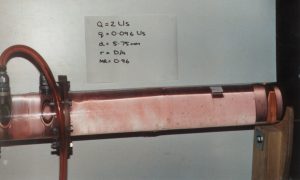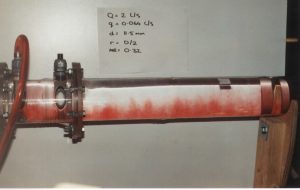Coefficient of Variation (CoV)
When two fluids are mixed in a pipe or channel, the quality of the radial mixing (across the pipe or channel) can be described statistically by the coefficient of variation, CoV, which is defined as:
 Where:
Where:-
- ci = is the difference between the background concentration and that of the flow plus additive
- cave = is the c averaged for each of the probes
- n = is the number of positions where concentration is measured
- cmean is the mean concentration of each of the probes
-
∑ is the sum of all the terms in brackets i.e.

- About 2/3 of the values will lie within c(1 ± CoV)
- About 95% of the values will lie within c(1 ± 2CoV)
-
About 99.75% of the values will lie within c(1 ± 3CoV).
The lower the value of CoV, the better the mixture quality. The required level of mixture quality is usually process specific. However, a CoV of between 0.01 and 0.05 is a reasonable target for most applications. This means that 95% of all concentration measurements to be taken from the pipe or channel cross section will be within ±2% of the mean concentration for CoV=0.01 and ±10% for CoV=0.05.
The photographs below illustrate different mixture qualities over a 5D distance from the dosing point:
CoV = 0.03 Good mixing

CoV = 0.18 Poor mixing

Reproduced with the kind permission of BHR Group Ltd.
